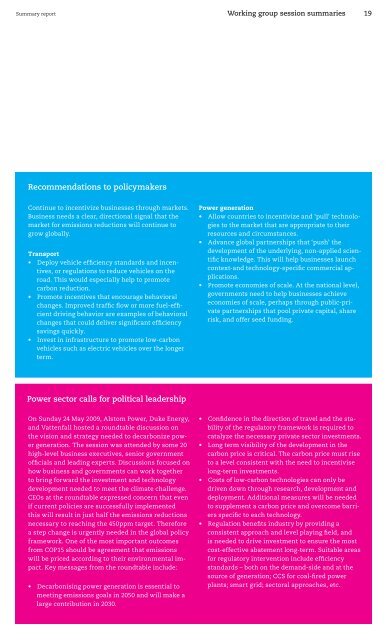pdf download - Sustainia
pdf download - Sustainia
pdf download - Sustainia
You also want an ePaper? Increase the reach of your titles
YUMPU automatically turns print PDFs into web optimized ePapers that Google loves.
Summary report Working group session summaries 19Recommendations to policymakersContinue to incentivize businesses through markets.Business needs a clear, directional signal that themarket for emissions reductions will continue togrow globally.Transport• Deploy vehicle efficiency standards and incentives,or regulations to reduce vehicles on theroad. This would especially help to promotecarbon reduction.• Promote incentives that encourage behavioralchanges. Improved traffic flow or more fuel-efficientdriving behavior are examples of behavioralchanges that could deliver significant efficiencysavings quickly.• Invest in infrastructure to promote low-carbonvehicles such as electric vehicles over the longerterm.Power generation• Allow countries to incentivize and ‘pull’ technologiesto the market that are appropriate to theirresources and circumstances.• Advance global partnerships that ‘push’ thedevelopment of the underlying, non-applied scientificknowledge. This will help businesses launchcontext-and technology-specific commercial applications.• Promote economies of scale. At the national level,governments need to help businesses achieveeconomies of scale, perhaps through public-privatepartnerships that pool private capital, sharerisk, and offer seed funding.Power sector calls for political leadershipOn Sunday 24 May 2009, Alstom Power, Duke Energy,and Vattenfall hosted a roundtable discussion onthe vision and strategy needed to decarbonize powergeneration. The session was attended by some 20high-level business executives, senior governmentofficials and leading experts. Discussions focused onhow business and governments can work togetherto bring forward the investment and technologydevelopment needed to meet the climate challenge.CEOs at the roundtable expressed concern that evenif current policies are successfully implementedthis will result in just half the emissions reductionsnecessary to reaching the 450ppm target. Thereforea step change is urgently needed in the global policyframework. One of the most important outcomesfrom COP15 should be agreement that emissionswill be priced according to their environmental impact.Key messages from the roundtable include:• Decarbonising power generation is essential tomeeting emissions goals in 2050 and will make alarge contribution in 2030.• Confidence in the direction of travel and the stabilityof the regulatory framework is required tocatalyze the necessary private sector investments.• Long term visibility of the development in thecarbon price is critical. The carbon price must riseto a level consistent with the need to incentiviselong-term investments.• Costs of low-carbon technologies can only bedriven down through research, development anddeployment. Additional measures will be neededto supplement a carbon price and overcome barriersspecific to each technology.• Regulation benefits industry by providing aconsistent approach and level playing field, andis needed to drive investment to ensure the mostcost-effective abatement long-term. Suitable areasfor regulatory intervention include efficiencystandards – both on the demand-side and at thesource of generation; CCS for coal-fired powerplants; smart grid; sectoral approaches, etc.



